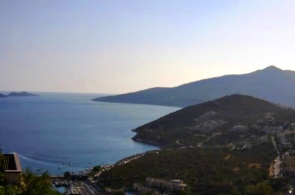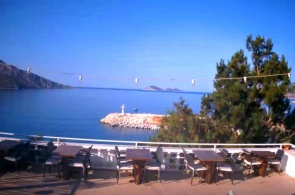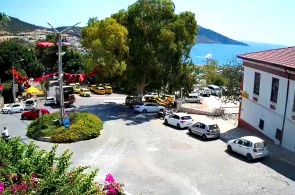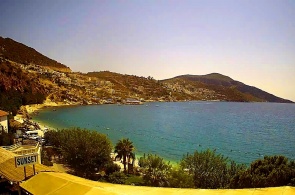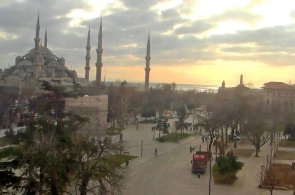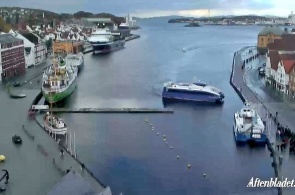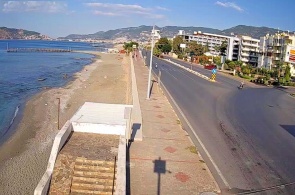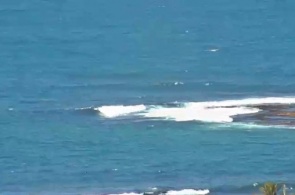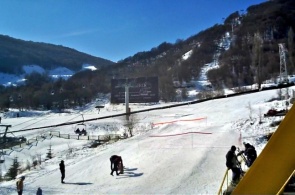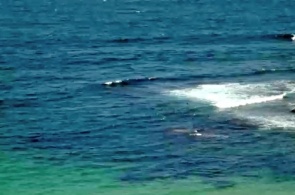Kalkan is not very rich in outstanding sights, except for historical structures, which are preserved here with special trepidation. But in the vicinity of the town you can find many interesting places.
So, for example, about an hour's drive from Kalkan is the Saklikent Gorge, which is considered the second largest in Europe. Its length reaches 20 km. Sheer cliffs towering over the river, waterfalls, the freshness of dense vegetation, as well as several cozy restaurants will give you an unforgettable vacation away from the hustle and bustle of large resorts. The best time to visit this place is late May - early September. It is recommended to use comfortable shoes that you do not mind getting wet. If you wish, you can rent rubber boots at the entrance to the gorge.
4 km from this place there is another attraction - the historical settlement of Tlos, which is one of the oldest in Lycia. On the territory of the settlement, there are ancient tombs, including the sarcophagus of Bellerophon. The tomb is decorated with an image of a hero riding a pegasus.
It is definitely recommended to visit the island of Kekova with the town of Kalekey. This trip will give at the same time a lot of sun, relaxation and new knowledge about the ancient culture. Here is the sunken city of Simena, which was originally divided into two parts - island and mainland. On the coast of the mainland, you can find the old fishing village of Kalekei, with many medieval structures, including a castle built by the Knights of Rhodes. Also here you can see the smallest Lycian amphitheater, located on the top of one of the mountains, from where amazing views open.
Across the bay is the insular part of Simena, where you can see the partially flooded ruins of the ancient city. Houses and streets descending under the water look at the same time eerie and mesmerizing. You can get here from the village of Uchagiz by renting a boat with a glass bottom, through which you can clearly see the entire underwater part of the sunken city.
Another important Lycian city was Mira, or Myra. Today you can see the ancient amphitheater, stone tombs located in the rock. There is also the Church of St. Nicholas the Wonderworker. It is adorned with elaborate marble mosaic floors. There are also preserved ancient frescoes. It is also known that a tomb was found relatively recently on the territory of the temple, which, according to presumably data, is the burial place of the saint himself.
So, for example, about an hour's drive from Kalkan is the Saklikent Gorge, which is considered the second largest in Europe. Its length reaches 20 km. Sheer cliffs towering over the river, waterfalls, the freshness of dense vegetation, as well as several cozy restaurants will give you an unforgettable vacation away from the hustle and bustle of large resorts. The best time to visit this place is late May - early September. It is recommended to use comfortable shoes that you do not mind getting wet. If you wish, you can rent rubber boots at the entrance to the gorge.
4 km from this place there is another attraction - the historical settlement of Tlos, which is one of the oldest in Lycia. On the territory of the settlement, there are ancient tombs, including the sarcophagus of Bellerophon. The tomb is decorated with an image of a hero riding a pegasus.
It is definitely recommended to visit the island of Kekova with the town of Kalekey. This trip will give at the same time a lot of sun, relaxation and new knowledge about the ancient culture. Here is the sunken city of Simena, which was originally divided into two parts - island and mainland. On the coast of the mainland, you can find the old fishing village of Kalekei, with many medieval structures, including a castle built by the Knights of Rhodes. Also here you can see the smallest Lycian amphitheater, located on the top of one of the mountains, from where amazing views open.
Across the bay is the insular part of Simena, where you can see the partially flooded ruins of the ancient city. Houses and streets descending under the water look at the same time eerie and mesmerizing. You can get here from the village of Uchagiz by renting a boat with a glass bottom, through which you can clearly see the entire underwater part of the sunken city.
Another important Lycian city was Mira, or Myra. Today you can see the ancient amphitheater, stone tombs located in the rock. There is also the Church of St. Nicholas the Wonderworker. It is adorned with elaborate marble mosaic floors. There are also preserved ancient frescoes. It is also known that a tomb was found relatively recently on the territory of the temple, which, according to presumably data, is the burial place of the saint himself.
More details
The view opens from one of the buildings of Villa Venus in Kalkan (Turkey). The lens captures mountains covered with dense forests, where numerous hotels, villas, apartments and residential buildings are huddled. On the left side of the image there is an excellent view of the sea bay. Villa Venus has its own well-established tourist infrastructure, including its own beach, swimming pools, garden, etc.
Kalkan, Turkey
14.08.21
The camera overlooks the Fish Terrace restaurant, owned by the Korsan complex in the Turkish town of Kalkan. In the restaurant "Rybnaya Terrace" guests can taste delicious dishes from freshly caught fish. Your meal will be complemented by a beautiful view of the Mediterranean Sea. The broadcast is carried out in real time.
Kalkan, Turkey
14.08.21
The camera is positioned in the center of the city of Kalkan (Turkey). The lens captures car traffic along the ring, sidewalks adjacent to the carriageway, buildings, green spaces. In the background, you can see a fragment of the bay and mountain slopes descending to the sea. The broadcast is carried out in real time.
Kalkan, Turkey
14.08.21
The webcam is broadcasting from the city of Kalkan (Turkey). The overview covers a picturesque view of the city beach, surrounded by mountain peaks, palms and other exotic trees. In the foreground, the roofs of local catering establishments and car parking are visible. Further you can see the sea surface and mountains. The broadcast is carried out in real time.
Kalkan, Turkey
14.08.21
popular camerasshow all
Sultanahmet or Blue mosque is a work of art of Turkish-Islamic architecture. Its construction began in 1609, the construction work took seven years to a 19-year-old Sultan. The name of the mosque was, due to its interesting and unique finish.
Istanbul, Turkey
08.02.14
Stavanger, a town in the commune of Norway, located in the South-Western part of the country, on the Peninsula, rich in minerals. Tanager combines the influence of foreign organisations such as NATO and oil companies. The camera will shoot the harbour and the promenade of the city.
Stavanger, Norway
03.11.13
A webcam broadcasts the district of Tosmur - quiet location in the Eastern part of Alanya, located only five kilometres from the city centre. Its rural way of life and the beauty of untouched nature attract tourists.
Alanya, Turkey
10.11.18
Shark Island or in English of Shark island, located in the harbour city of Sydney, the suburb of Point Piper. The locals, the natives named the island Boambilly, which translated means Shark island. After all, this name is not casual, because it's mean and looks like a shark fin.
Sydney, Australia
31.10.13
The webcam is installed on site Alva. Tsaghkadzor ski resort town in Armenia. Tsaghkadzor is a beautiful mountainous area among deciduous forests, with a pleasant winter climate, and clean fresh air. The highest point is 1800 meters. The truss type is a classic, divided into three.
Tsakhkadzor, Armenia
18.01.14

